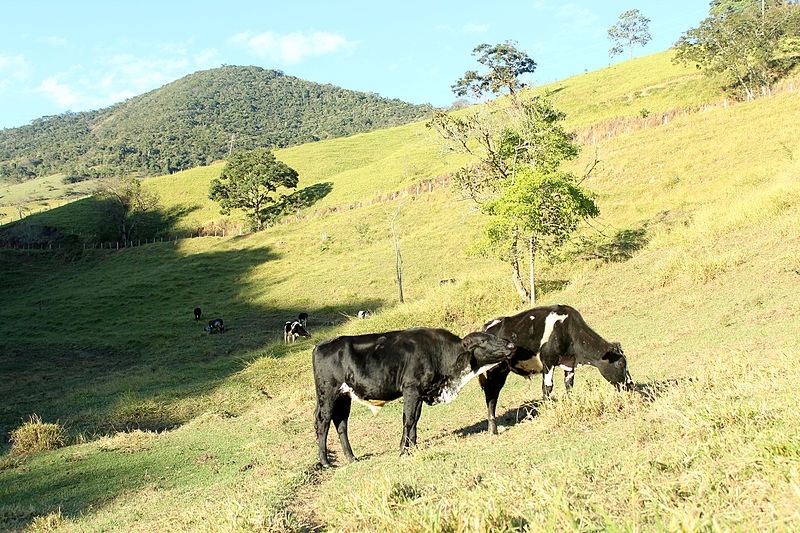

Some 90% of the soil macrofauna disappears when forest is converted into pasture and then into cropland for growing sugarcane (photo: Wikimedia Commons)
Some 90% of the soil macrofauna disappears when forest is converted into pasture and then into cropland for growing sugarcane.
Some 90% of the soil macrofauna disappears when forest is converted into pasture and then into cropland for growing sugarcane.

Some 90% of the soil macrofauna disappears when forest is converted into pasture and then into cropland for growing sugarcane (photo: Wikimedia Commons)
By Peter Moon | Agência FAPESP – Research conducted at the University of São Paulo’s Center for Nuclear Energy in Agriculture (CENA-USP) in Piracicaba, Brazil, has measured the impact on soil biodiversity of the conversion of forest into pasture and then into cropland for growing sugarcane.
The conclusion is that these land use changes have a devastating impact on the original soil macrofauna, comprising termites, ants, snails, earthworms, beetles, spiders, scorpions and woodlice, among others: 90% disappear completely.
The research was conducted by André Luiz Custodio Franco during his doctorate and a research internship abroad, both supported by scholarships from FAPESP and supervised by Professor Carlos Clemente Cerri.
The results have recently been published in the journal Science of the Total Environment.
“We set out to see how land use changes interfere with greenhouse gas emissions and soil carbon storage and, consequently, how they affect the composition of organic matter,” Franco said.
Invertebrates, microorganisms and fungi, which form the soil microfauna, play a major role in soil recycling thanks to activities that break down organic matter. Ants and termites, which are part of the soil macrofauna, are the key stabilizing agents, mainly because their nest-building activities prevent soil erosion.
To measure the effects of land use changes on biodiversity, the researchers extracted soil blocks from several layers, down to a depth of 30 cm. These samples were collected from three sugarcane plantations located in Jataí, Goiás State, and in Ipaussu and Valparaíso, São Paulo State. Samples of native vegetation were also collected to demonstrate soil biodiversity in a stable system before clearance for use as pasture.
“When native forest is converted to pasture, all the topsoil predators disappear, especially spiders and scorpions,” Franco said. “In the absence of predators, the termite and earthworm populations explode. The number of termites in the soil increases nine-fold, and the number of earthworms grows fourteen-fold.”
On the other hand, when pasture is converted into sugarcane acreage, the termite and earthworm populations are also eliminated owing to chemical soil correction.
The native soil is slightly acidic, and invertebrates and microorganisms are adapted to live in a moderately acidic environment. Because sugarcane requires alkaline soil, vast quantities of lime are introduced by the cane agroindustry, as well as fertilizer, herbicides and pesticides. “This makes the soil toxic, especially for earthworms,” Franco said.
Chemical soil correction, along with the subsequent use of chemical fertilizer, results in almost complete elimination of the soil’s biodiversity. The few animals and microorganisms capable of adapting to slightly alkaline soil are eliminated by the agrochemicals.
“About 90% of the soil macrofauna disappears. In terms of animal groups, 40% are lost,” Franco said. In a sugarcane plantation, therefore, biodiversity has been wiped out, and this makes the soil unstable.
Termites and ants are “soil engineers,” as Franco put it. They are important for maintaining soil stability. Where there are more animals, the soil is more stable. Thus, having fewer animals means less stability and a greater risk of erosion.
Another problem is the loss of soil carbon. The activities of termites and ants lead to carbon sequestration in clay or sand microaggregates, which protect carbon particles from decomposition by microorganisms. The carbon particles that pass through earthworm digestive tracts are stabilized and encapsulated so that microorganisms cannot reach them.
The loss of macrofauna puts the soil’s stability and carbon storage capacity at risk, as well as contributing to the release of carbon into the atmosphere.
The article “Loss of soil (macro)fauna due to the expansion of Brazilian sugarcane acreage” by André L.C. Franco, Marie L.C. Bartz, Maurício R. Cherubin, Dilmar Baretta, Carlos E.P. Cerri, Brigitte J. Feigl, Diana H. Wall, Christian A. Davies and Carlos C. Cerri, published in Science of the Total Environment, can be read at sciencedirect.com/science/article/pii/S0048969716308117.
Republish
The Agency FAPESP licenses news via Creative Commons (CC-BY-NC-ND) so that they can be republished free of charge and in a simple way by other digital or printed vehicles. Agência FAPESP must be credited as the source of the content being republished and the name of the reporter (if any) must be attributed. Using the HMTL button below allows compliance with these rules, detailed in Digital Republishing Policy FAPESP.




